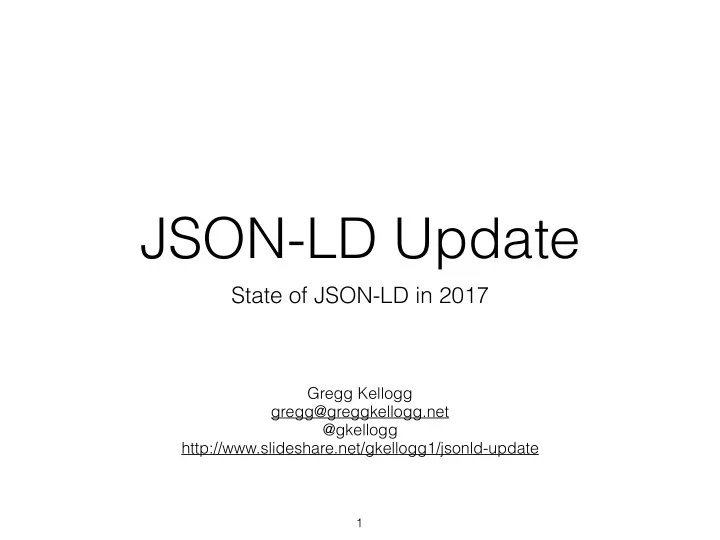

JSON-LD Update State of JSON-LD in 2017 Gregg Kellogg gregg@greggkellogg.net @gkellogg http://www.slideshare.net/gkellogg1/jsonld-update 1
Quite Successful Format • The October 2016 Common Crawl reports over 2 million (out of 3 million) HTML pages include JSON-LD [1]. • JSON-LD is one of the formats supported by schema.org, in addition to Microdata and RDFa [2]. • JSON-LD is a required format in the Linked Data platform [3]. • JSON-LD is becoming popular for many other REST APIs. [1] webdatacommons.org/structureddata/#results-2016-1 [2] http://blog.schema.org/2013/06/schemaorg-and-json-ld.html [3] https://www.w3.org/TR/ldp/ 2
Keys to Success • A primary goal was to allow JSON developers to use it as if it is normal JSON. The syntax is designed to not disturb already deployed systems running on JSON, but provide a smooth upgrade path from JSON to JSON-LD. Since the shape of such data varies wildly, JSON-LD features mechanisms to reshape documents into a deterministic structure which simplifies their processing [4]. • JSON-LD allows developers to focus on the JSON, but modelers to get back to the RDF data model for semantic analysis and validation. [4] https://www.w3.org/TR/json-ld/ 3
JSON-LD – Key Features • Add @context to JSON to associate terms (properties) with IRIs which define them. • Describe the expected types for string values of properties • IRI, Dates, Numbers, … • Treat collections as lists or sets. • Encourage the use of well-known identifiers for entities, and provide typing ( @id and @type ). • (much more, see JSON-LD 1.0 for a complete feature set). 4
JSON-LD 1.1 • It’s been three years since JSON-LD 1.0 was published, and feature requests have been mounting: • Use objects to index into collections, rather than an array form • Previously restricted to @index and @language . Now available on @id and @type . • Framing, never complete in 1.0. Now provides ability to match on @id , inclusive or exclusive @type , property values, and specifics of a value object. • Contexts scoped to terms: property values or entities using a given type term can overlay terms-specific contexts. • Ignore some elements of JSON structure. 5
@id Maps { "@context": { "schema": "http://schema.org/", "name": "schema:name", "body": "schema:articleBody", "words": "schema:wordCount", "post": { "@id": "schema:blogPost", "@container": "@id" } }, "@id": "http://example.com/", "@type": "schema:Blog", "name": "World Financial News", "post": { "http://example.com/posts/1/en" : { "body": "World commodities were up today with heavy trading of crude oil...", "words": 1539 }, "http://example.com/posts/1/de" : { "body": "Die Werte an Warenbörsen stiegen im Sog eines starken Handels von Rohöl...", "words": 1204 } } } 6
Nested Properties { "@context": { "skos": "http://www.w3.org/2004/02/skos/core#", "labels": "@nest" , "main_label": {"@id": "skos:prefLabel"}, "other_label": {"@id": "skos:altLabel"}, "homepage": {"@id": "http://schema.org/description", "@type": "@id"} }, "@id": "http://example.org/myresource", "homepage": "http://example.org", "labels" : { "main_label" : "This is the main label for my resource", "other_label" : "This is the other label" } } 7
Scoped Contexts { "@context": { "name": "http://schema.org/name", "interest": { "@id":"http://xmlns.com/foaf/0.1/interest", "@context": {"@vocab": "http://xmlns.com/foaf/0.1/"} } }, "name": "Manu Sporny", "interest": { "@id": "https://www.w3.org/TR/json-ld/", "name" : "JSON-LD", "topic" : "Linking Data" } } 8
Scoped Contexts (@type) { "@context": { "name": "http://schema.org/name", "interest": "http://xmlns.com/foaf/0.1/interest", "Document": { "@id": "http://xmlns.com/foaf/0.1/Document", "@context": {"@vocab": "http://xmlns.com/foaf/0.1/"} } }, "@type": "Person", "name": "Manu Sporny", "interest": { "@id": "https://www.w3.org/TR/json-ld/", "@type": "Document" , "name": "JSON-LD", "topic": "Linking Data" } } 9
JSON-LD 1.1 Timeline • All work being done in Community Group [5][6]. • With enough interest, a Working Group could be spun up to create a Recommendation, and possibly address additional requirements. • Topic for TPAC 2017? • Expect community drafts to complete in Q2 2017. • Ruby implementation conforms to all changes in CG specs • Changes likely easily applied to Python, Javascript, PHP, Java, C#, Go and other implementations. • Still no publicly available implementation in “C”. [5] https://www.w3.org/community/json-ld/ [6] http://json-ld.org 10
Related Topics for Web of Things 11
Shape Expressions (ShEx) { "type":"Schema", "shapes": [{ • ShEx [7] is used for "id": "http://schema.example/PersonShape", “type": "Shape", "expression": { "type": "TripleConstraint", validating graph "predicate": "http://xmlns.com/foaf/0.1/ name" patterns, similar to, } }, { "id": "http://schema.example/EmployeeShape":, but less complex then "type": "Shape", "expression": { “type": "EachOf", "shapeExprs": [ “http://schema.example/PersonShape", SHACL. { "type": "TripleConstraint", "predicate": "http://schema.example/ employeeNumber" } ] • JSON grammar is } }] } JSON-LD/RDF. Also has Compact ex:PersonShape { foaf:name . } Grammar. ex:EmployeeShape { &ex:PersonShape ; ex:employeeNumber . } [7] https://shexspec.github.io/spec 12
Decentralized Identifiers • The WebDHT [8] proposes to use the block-chain for as an identifier space with immutable content in the block chain. • Content is a JSON-LD document, so may be used as the target of a @context . • Content will not change, so may be cached or distributed out-of-band. • Content signed to guarantee veracity. [8] http://opencreds.org/specs/source/webdht/ 13
Linked Data Signatures • Mechanism for signing Linked Data documents [9] • Part of the work of the Digital Verification Community Group [10] { "@context": "https://w3id.org/identity/v1", "title": "Hello World!", "signature": { "type": "LinkedDataSignature2015", "creator": "http://example.com/i/pat/keys/5", "created": "2011-09-23T20:21:34Z", "domain": "example.org", "nonce": "2bbgh3dgjg2302d-d2b3gi423d42", "signatureValue": "OGQzNGVkMzVm4NTIyZTkZDY...NmExMgoYzI43Q3ODIyOWM32NjI=" } } [9] https://w3c-dvcg.github.io/ld-signatures/ [10] https://w3c-dvcg.github.io/ 14
RDF Dataset Normalization • Creates a reproducible hash of an RDF Dataset [11]. • Derived from JSON-LD using toRdf algorithm. • Basis of signing linked data • Not tied to syntax, so invariant to minor formatting changes [11] http://json-ld.github.io/normalization/spec/ 15
Verifiable Claims • Close to becoming a Working group [12]. • Could be a source of identity for WoT. • Defines a data model and syntax for making claims [13]. [12] http://w3c.github.io/vctf/charter/proposal.html [13] https://opencreds.github.io/vc-data-model/ 16
Recommend
More recommend